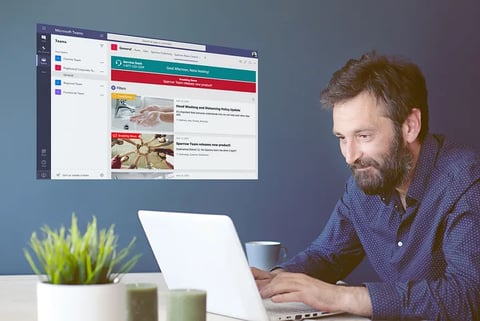Every industry has its challenges when it comes to workforce communications, and the construction industry brings a number of them all together.
Reaching Field Workers
A typical construction site has hundreds of individuals working at any time. That workforce is made up of a mix of full-time and employees, as well as contractors and subcontractors. Some construction sites even have several shifts overlapping by a few minutes. In addition, the age range can be significant, adding additional complexity in terms of preferred means for being communicated with.
Managers in construction are excellent engineers and senior tradesmen, but they usually find corporate communication to their crews challenging. Unfortunately, most organizations rely on managers to handle the lion’s share of communications, since they have corporate email accounts and have access to the corporate network. The managers are the ones tethered to the organization’s digital communication ecosystem, and therefore it falls upon them to be the hub connecting to everyone at the site. Relying on managers produces mixed outcomes. Some managers will be better at sharing information and keeping everyone informed than others. This inevitably leads to inconsistencies with how your communication is perceived and interpreted. Also, when things get extremely busy, communications can often fall off the side of the desk in favor of “just getting things done”, which can lead to more issues down the line.
The ability to invite everyone to a common communication platform is crucial to avoid cost overruns, delays, and reduce disputes among stakeholders, but more importantly to reduce the communications burden on those managers. You cannot afford to rely on managers to understand and communication down your message, instead shifting them to being the ones to reinforce the messaging can have a profound impact. Modern communication platforms such as Sparrow, allow you communicate directly with your workforce and stakeholders, get their feedback and measure their interactions with your content, and have those managers focused on what’s critical for the success of the site and the team.
Health and Safety
The construction industry is a high-risk work environment and these risks are reflected in the statistics. In the U.S. more than 200,000 non-fatal construction injuries, and more than 900 fatal incidents, are reported each year. The fatality rate for the construction industry is higher than the national average for all industries. According to the Department of Labor, in the United States alone, one out of every five deaths in the workplace happens in the construction industry.
There are many factors involved in ensuring safety on work sites, but one of the most common reasons for many job site injuries is poor communication. Studies have shown that around 36% of employees have been placed in an unsafe situation because of poor communication.
The ability to send mandatory and compliance communication will help you establish a workplace culture of health and safety awareness. This will ensure that clear instructions are given so that safety procedures can be followed thus reducing safety incidents. With a modern communication platform such as Sparrow you can:
- Ensure all your workers get timely safety information including HSE policies.
- Have a common HSE terminology that is understood by everyone.
- Provide a platform for workers to speak out when they discover a safety hazard. They may fear criticism if they point out a potential hazard to a peer or a supervisor.
When workers are involved in a work-related injury, it can result in loss of productivity, additional costs, project delays, and decreased morale for the team. Much of this could be avoided if the safety communications got all workers on the same page and speaking the same language.
Communicating in multiple languages
Construction is a multicultural industry. A telling statistic from the US Bureau of Labor Statistics describes this situation – foreign-born workers are 14% more likely to be employed in construction compared to native-born workers.
So, it is common to have a multicultural workforce with different backgrounds working together. Communicating in the native tongue of your employees has become a necessity in the construction industry to avoid miscommunication as information becomes lost in translation.
You have limited resources and most companies cannot afford translation services. An alternative is to have a platform that can automatically do most of the work for you. Using cognitive services, Sparrow and similar platforms, can do draft translations in real-time making the job of communicating in multiple languages as easy as pushing a button.
COVID-19
The construction industry has been declared an essential service in North America and has been allowed to continue to operate. A new set of policies have been hurriedly drafted, from return to work, to social distancing, cleaning, and travel. All with the goal of avoiding spread and the potential for positive COVID-19 cases on-site.
This situation continues to change quickly, as local, state, and federal regulations are changed, clear and concise communication with employees has become essential.
Some organizations have been relying on printed memos, emails, and newsletters to communicate COVID related information. Unfortunately, these channels have proven inefficient resulting in poor readership and engagement. They are also not suitable for instances in which you need active acknowledgment, say for a changed mask policy.
To effectively communicate COVID-19 information you need to:
- Reach everyone in a relative short amount of time. Time is usually of the essence when updating COVID-19 policies.
- Get active acknowledgement from your workforce. You need to track who has viewed the information and who has indicated compliance. For example, Return to Work policies need to be complied with prior to showing up onsite.
In Summary
The quality of communication can be the difference between a profitable project and a so-so project. Communication can be greatly enhanced by using a platform such as Sparrow.
Sparrow provides the ability to communicate in real-time critical information to all stakeholders. If all stakeholders are on the same page, the better chance everyone is set up for a successful project.
Are you ready for a modern, vibrant communication platform? We’d love to introduce you to Sparrow.




